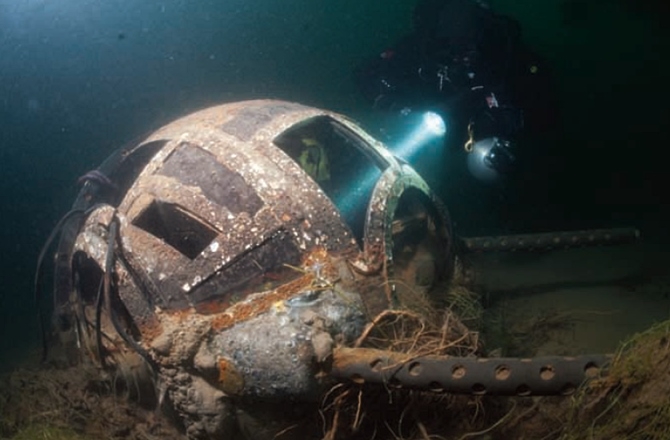Those are the words that were painted on a World War Two B-17 bomber which was found at the bottom of a lake in Italy. These words are more than just that, they are someone’s name. The wreckage of a B-17 bomber, which has been dubbed a “flying fortress” crashed in Lake Bolsena over 70 years ago. After a recent effort to bring the aircraft up from the 300 foot deep grave, the plane has been identified.
With a combined effort of the Viterbo Fire Department and the Research Center of the Scuba School of Lake Bolsena, several pieces of the plane that was scattered on the lake’s bottom were able to be identified. This included the Sperry ball turret—a capsule that kept the gunner save at the bottom of the plane. The turret had been placed on display at a local museum last month. On the turret, there were the words “Ileen Lois” hand painted on it.
“The words were still visible after 70 years underwater on the right and left side of the turret. They allowed us to identify the plane, reconstruct its history and the fate of its crew,” Mario Di Sorte tells Discovery News. Di Sort is a historian who researched the mystery behind the sunken plane.
The International Group for Historic Aircraft Recovery (TIGHAR) and their supports managed to help Di Sorte uncover the words that meant to Lois Eileen—a young woman married to Sergeant Ralph Truesdale, the plane’s gunner. He was among 9 others on the ill-fated B-17 plane. “Having his wife’s name written on the sides of the turret was a gesture of love which made him feel closer to her during the war missions,” Di Sorte said. It wasn’t just Truesdale’s idea to write the name of a love on the plane. The whole crew had agreed to call the plane “Ethel” after the girlfriend of Anthony Brodniak, the right waist gunner.
The B-17 belonged to the 429th Squadron of the US Army Air Forces, which operated from Amendola, located near Foggia in Puglia. The last time “Ethel” flew was January 15, 1944. The plane’s final flight was part of a mission that involved the use of 38 other Flying Fortresses like “Ethel”. The group’s primary target was the railroad bridge that was in Certaldo, just south of Florence. The group did have an alternate target—the marshalling yards at Poggibonsi near Siena.
When the group was closer to Perguia, they encountered a massive attack from German anti-aircraft. During the first wave, seven B-17’s were seriously damaged. In the second wave, 18 were effected. The mission was a complete failure for those aboard the “Ethel”. The plane was struck by anti-aircraft fire and it damaged two of the engines. The plane was able to release six bombs onto the shores of Lake Transimeno, an effort to lighten its load.
“The bomber was out of control, so all 10 crewmen were forced to bail out,” Di Sorte said. The out of control plane crashed into Lake Bolsena. All 10 crew members parachuted from the plane; three of the men were captured by German forces and finished the war in POW camps located in North Germany, while the remaining seven were saved and kept hidden by families nearby. The pilot, William Pedersen, landed on an olive tree that grew near a farm house. He remained in at the farm house until Allied troops came on June 10, 1944. The co-pilot, Joseph Townsend had a similar fate and he, too, remained hidden until the Allied forces arrived almost five months later.
Others in the crew remained together for only a few days until they collectively decided that it would be best if they escaped alone. “Those wonderful Italians gave us whatever food they could spare, never asking for anything in return…. I found out later that anyone helping Allied airmen, soldiers, escapees, would be put to death and their families as well,” upper turret gunner Bernard Scalisi recalled later.
Scalisi and Brodniak was able to escape and make their way to Rome. Here they scaled the walls of the Vatican City and remained in hiding until June 5th, 1944 when the Allies arrived. Truesdale escaped alone and was captured by Germans. He was taken to a Transit Prison Camp that wasn’t too far from Rome. Back in the US, Lois tried desperately to learn of her husband’s fate. The St. Petersburg Times posted a picture of Lois and her child with the caption: “They hope and wait.”
27 days had passed before Truesdale was able to escape the POW camp. He hid for 3 months until the Allies came to the area.
Despite their wartime love story, love did not last for Ralph and Lois. The couple divorced in 1947.
